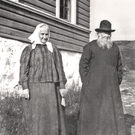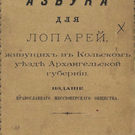The Lappish language and alphabet
The Lappish language (Russian Lapland)
The Lapps of Nota Lake and Songelsk tribes spoke the Notozera dialect of Sami-Skolt language (in short “Skolt”). There is only one Lapp left in Russia, whose native tongue is Skolt and he is Gerasimov Alexander Ivanovich of the ancient Gerasimov family. Alexander Ivanovich still lives in the Upper-Tuloma and was born in the Lapp-Finnish settlement of Ristikent (Nota Lake Settlement), which was flooded by the Upper-Tuloma reservoir.
Apart from the Nota Lake dialect, the Sami-Skolt language of the Russian Lapps, there are other dialects: Babinsk dialect (akkala), Jukansko-Sami language (Tersk-Lappish), and imander and kildinsk dialects.
The Finnish ethnographic and linguistic study states that the Lapps of the Kola Peninsula speak 3 or 4 completely different languages or dialects, often switching from one dialect to the other, but sometimes these dialects so much differ from each other that, for example, the residents of Ponoisk and Lovozero settlements could hardly manage to understand each other in their native tongues. The Kildinsk dialect serves a transformer to the dialects of the western Lapps, among which the Nota Lake dialect is considered as the most rotund or the so-called “Parisian dialect”. It even astonishes any person without the knowledge of the Lappish language with its elongated sounds, which resemble the frog’s piping, whereas the Imander dialect is very pleasant resembling the songs of the birds, especially when spoken by women. As per the language the Russian and Finnish Lapps have no commonalities, except for the fact that they both have the same origin.
The Lappish alphabet
The first Lappish alphabet was based on Latin letters. But the first translation of parts of the New Testament, Mathew’s bible, was translated in Skolt, using Russian alphabet and was published in 1894 by the Russian Orthodox Priest, teacher at the church school of the Pazretsko Parish, elder of the church of St Boris and Gleb situated at the border with Norway
, Constantine Prokopievich (1867 – November 1916). He was the same person, who in1895, published the first alphabet for Lapps speaking Nota Lake dialect using the Russian alphabet as source. The Pazreki Lapps (currently the Boris Glebsky settlement) spoke the Nota lake dialect (Skolt).The first of the Soviet attempts at creating a Lappish script took place at the end of 1920s. An alphabet, which comprised of letters from other nations, and was based on the Latin letters, was approved in 1931. This alphabet was reformed in 1933 and 1934.
The alphabet based on Cyrillic letters was designed and approved in 1937 and contained all the Russian letters, except for Щ щ, as well as the digraph Нг нг. This alphabet was used to publish the first book of alphabets, but after that the publishing of Sami books was stopped for a long time in the Soviet Union. The matter of reinstating the Lappish language was raised again in the 1970s. a new alphabet was designed and approved (in 1982).
Sami language in other countries
Western Sami group
- South-Sami language — Norway and Sweden
- Ume-Sami language (uume) — Norway and Sweden
- Lule-Sami language (luule) — Norway and Sweden
- Pite-Sami language (pite) — Norway and Sweden
- Northern-Sami language — Norway, Sweden and Finland
The Eastern-Sami group
- Kemi-Sami language † — Samis of central Finnish Lapland
- Inari-Sami language — Finland
Dictionary
- Mother — jaina
- Grandmother — agka
- Large family — shurr piras
- Sun — kolo
- Gold — kol
- Steel — ruvt
- Blood — vyrr
- Water — jul
- Fish — kul (Finnish, Kala)
- Ear — kuljul
- Garua — seti
- Kumzha — kuvch
- Pike — nukkesh
- Perch — vyjek
- Char — jidich
- Whitefish — shapp
- Lake char — ravt
- Trout — kaudsher
- Dog fish — vueshn
- Grayling — sovvel
- Salmon (plural) — luz
- Salmon (singular) — luss
- Young salmon — mezhen
- Frog — atsak
- To hunt — urdovag
- Height — urt
- Leading reindeer — hirvas, irvas, kodd
- Male reindeer — Serves
- Lead reindeer — Puade
- Moose — Sarva
- Male moose — Sarvvis
- Beaver — maiy
- Arctic fox — nyal
- Squirrel — uarrev
- Otter — chevres
- Wolverine — ketk
- Eared seal — rokk
- Kai — chaika
- Island — suel, suol
- Bald mountain — Varr, var — forest, or forest covered hill (Finnish, vaara)
- Wood, vyd — a hill rising higher than the forest’s top
- Jok — river (Finnish, joki)
- Pai — upper
- Porr — a ridge with a sharp crest
- Uaiv, oaiv — hilltop
- Ujavench — top
- Chorr — ridge
- Javr, Jaur — lake (Finnish Javri)
- Syakhtar — red moss
- Somshit — black moss

